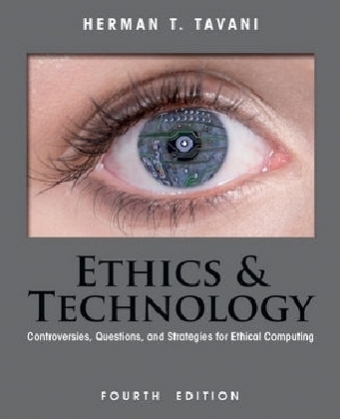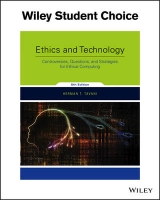
Ethics and Technology
John Wiley & Sons Inc (Verlag)
978-1-118-28172-7 (ISBN)
- Titel erscheint in neuer Auflage
- Artikel merken
Updates to the 4th Edition include * New or updated scenarios in each chapter * New sample arguments in many chapters, which enable students to apply the tools for argument analysis covered in Chapter 3 * Newly designed set of study/exercise questions call Unalyzed Scenarios in each chapter, which can be used for either in-class group projects or outside class assignments * Additional review, discussion, and essay/presentation questions at the end of many chapters New Issues Examined and Analyzed include * Ethical and social aspects of Cloud Computing, including concerns about the privacy and security of users' data that is increasingly being stored in "the Cloud" * Concerns about the increasing "personalization" of search results based on queries entered by users on search engines such as Google * Controversies surrounding Wikileaks and the tension it creates between free speech and responsible journalism * Concerns affecting "net neutrality" and whether Internet regulation may be required to ensure that service providers on the Internet do not also unduly control the content delivered via their services * Recent controversies affecting "machine ethics" and the development of "moral machines" or autonomous systems that will be embedded with software designed for making moral decisions * Questions about our conventional notions of autonomy and trust--can machines be autonomous?
Can we trust machines to act in ways that will always be in the best interest of humans?
Herman T. Tavani is Professor of Philosophy at Rivier College and Co-Director of the International Society for Ethics and Information Technology (INSEIT). He is the author, editor, or co-editor of five books on ethical aspects of information technology.
PREFACE xvii ACKNOWLEDGMENTS xxvii FOREWORD xxix CHAPTER 1 INTRODUCTION TO CYBERETHICS: CONCEPTS, PERSPECTIVES, AND METHODOLOGICAL FRAMEWORKS 1 1.1 Defining Key Terms: Cyberethics and Cybertechnology 3 1.2 The Cyberethics Evolution: Four Developmental Phases in Cybertechnology 6 1.3 Are Cyberethics Issues Unique Ethical Issues? 9 1.4 Cyberethics as a Branch of Applied Ethics: Three Distinct Perspectives 14 1.5 A Comprehensive Cyberethics Methodology 24 1.6 A Comprehensive Strategy for Approaching Cyberethics Issues 27 1.7 Chapter Summary 28 CHAPTER 2 ETHICAL CONCEPTS AND ETHICAL THEORIES: ESTABLISHING AND JUSTIFYING A MORAL SYSTEM 33 2.1 Ethics and Morality 33 2.2 Discussion Stoppers as Roadblocks to Moral Discourse 42 2.3 Why Do We Need Ethical Theories? 52 2.4 Consequence-Based Ethical Theories 53 2.5 Duty-Based Ethical Theories 56 2.6 Contract-Based Ethical Theories 61 2.7 Character-Based Ethical Theories 64 2.8 Integrating Aspects of Classical Ethical Theories into a Single Comprehensive Theory 66 2.9 Chapter Summary 70 CHAPTER 3 CRITICAL REASONING SKILLS FOR EVALUATING DISPUTES IN CYBERETHICS 74 3.1 Getting Started 74 3.2 Constructing an Argument 78 3.3 Valid Arguments 80 3.4 Sound Arguments 83 3.5 Invalid Arguments 85 3.6 Inductive Arguments 86 3.7 Fallacious Arguments 87 3.8 A Seven-Step Strategy for Evaluating Arguments 89 3.9 Identifying Some Common Fallacies 91 3.10 Chapter Summary 98 CHAPTER 4 PROFESSIONAL ETHICS, CODES OF CONDUCT, AND MORAL RESPONSIBILITY 101 4.1 Professional Ethics 102 4.2 Do Computer/IT Professionals Have Any Special Moral Responsibilities? 105 4.3 Professional Codes of Ethics and Codes of Conduct 106 4.4 Conflicts of Professional Responsibility: Employee Loyalty and Whistle-Blowing 112 4.5 Moral Responsibility, Legal Liability, and Accountability 117 4.6 Risk Assessment in the Software Development Process 121 4.7 Do Some Computer Corporations Have Special Moral Obligations? 122 4.8 Chapter Summary 125 CHAPTER 5 PRIVACY AND CYBERSPACE 131 5.1 Are Privacy Concerns Associated with Cybertechnology Unique or Special? 132 5.2 What is Personal Privacy? 134 5.3 Why is Privacy Important? 139 5.4 Gathering Personal Data: Monitoring, Recording, and Tracking Techniques 141 5.5 Exchanging Personal Data: Merging and Matching Electronic Records 146 5.5.1 Merging Computerized Records 146 5.6 Mining Personal Data 150 5.7 Protecting Personal Privacy in Public Space 156 5.8 Privacy-Enhancing Technologies 162 5.9 Privacy Legislation and Industry Self-Regulation 164 5.10 Chapter Summary 168 CHAPTER 6 SECURITY IN CYBERSPACE 174 6.1 Security in the Context of Cybertechnology 174 6.1.1 Cybersecurity as Related to Cybercrime 175 6.2 Three Categories of Cybersecurity 176 6.3 Cloud Computing and Security 180 6.4 Hacking and The Hacker Ethic 183 6.5 Cyberterrorism 187 6.6 Information Warfare (IW) 191 6.7 Cybersecurity and Risk Analysis 194 6.8 Chapter Summary 196 CHAPTER 7 CYBERCRIME AND CYBER-RELATED CRIMES 201 7.1 Cybercrimes and Cybercriminals 201 7.2 Hacking, Cracking, and Counterhacking 203 7.3 Defining Cybercrime 205 7.4 Three Categories of Cybercrime: Piracy, Trespass, and Vandalism in Cyberspace 208 7.5 Cyber-Related Crimes 209 7.6 Technologies and Tools for Combating Cybercrime 213 7.7 Programs and Techniques Designed to Combat Cybercrime in the United States 216 7.8 National and International Laws to Combat Cybercrime 218 7.9 Cybercrime and the Free Press: The WikiLeaks Controversy 221 7.10 Chapter Summary 225 CHAPTER 8 INTELLECTUAL PROPERTY DISPUTES IN CYBERSPACE 230 8.1 What is Intellectual Property? 230 8.2 Copyright Law and Digital Media 235 8.3 Patents, Trademarks, and Trade Secrets 242 8.4 Jurisdictional Issues Involving Intellectual Property Laws 244 8.5 Philosophical Foundations for Intellectual Property Rights 245 8.6 The Free Software and the Open Source Movements 250 8.7 The Common-Good Approach: An Alternative Framework for Analyzing the 8.8 PIPA, SOPA, and RWA Legislation: Current Battlegrounds in the Intellectual 8.9 Chapter Summary 264 CHAPTER 9 REGULATING COMMERCE AND SPEECH IN CYBERSPACE 269 9.1 Background Issues and Some Preliminary Distinctions 270 9.2 Four Modes of Regulation: The Lessig Model 273 9.3 Digital Rights Management and the Privatization of Information Policy 274 9.4 The Use and Misuse of (HTML) Metatags and Web Hyperlinks 278 9.5 E-Mail Spam 281 9.6 Free Speech vs. Censorship and Content Control in Cyberspace 284 9.7 Pornography in Cyberspace 286 9.8 Hate Speech and Speech that can Cause Physical Harm to Others 292 9.9 Network Neutrality and the Future of Internet Regulation 294 9.10 Chapter Summary 297 CHAPTER 10 THE DIGITAL DIVIDE, DEMOCRACY, AND WORK 303 10.1 The Digital Divide 304 10.2 Cybertechnology and the Disabled 309 10.3 Cybertechnology and Race 312 10.4 Cybertechnology and Gender 314 10.5 Cybertechnology, Democracy, and Democratic Ideals 317 10.6 The Transformation and the Quality of Work 324 10.7 Chapter Summary 331 CHAPTER 11 ONLINE COMMUNITIES, CYBER IDENTITIES, AND SOCIAL NETWORKS 337 11.1 Online Communities and Social Networking Services 337 11.2 Virtual Environments and Virtual Reality 343 11.3 Cyber Identities and Cyber Selves: Personal Identity and Our Sense of Self in the Cyber Era 351 11.4 AI and its Implications for What it Means to be Human 355 11.5 Chapter Summary 363 CHAPTER 12 ETHICAL ASPECTS OF EMERGING AND CONVERGING TECHNOLOGIES 368 12.1 Converging Technologies and Technological Convergence 368 12.2 Ambient Intelligence (AmI) and Ubiquitous Computing 369 12.3 Bioinformatics and Computational Genomics 376 12.4 Nanotechnology and Nanocomputing 381 12.5 Autonomous Machines and Machine Ethics 389 12.6 A Dynamic Ethical Framework for Guiding Research in New and Emerging Technologies 402 12.7 Chapter Summary 404 GLOSSARY 411 INDEX 417
| Reihe/Serie | Delisted |
|---|---|
| Verlagsort | New York |
| Sprache | englisch |
| Maße | 191 x 233 mm |
| Gewicht | 652 g |
| Themenwelt | Mathematik / Informatik ► Informatik ► Theorie / Studium |
| ISBN-10 | 1-118-28172-1 / 1118281721 |
| ISBN-13 | 978-1-118-28172-7 / 9781118281727 |
| Zustand | Neuware |
| Haben Sie eine Frage zum Produkt? |
aus dem Bereich



